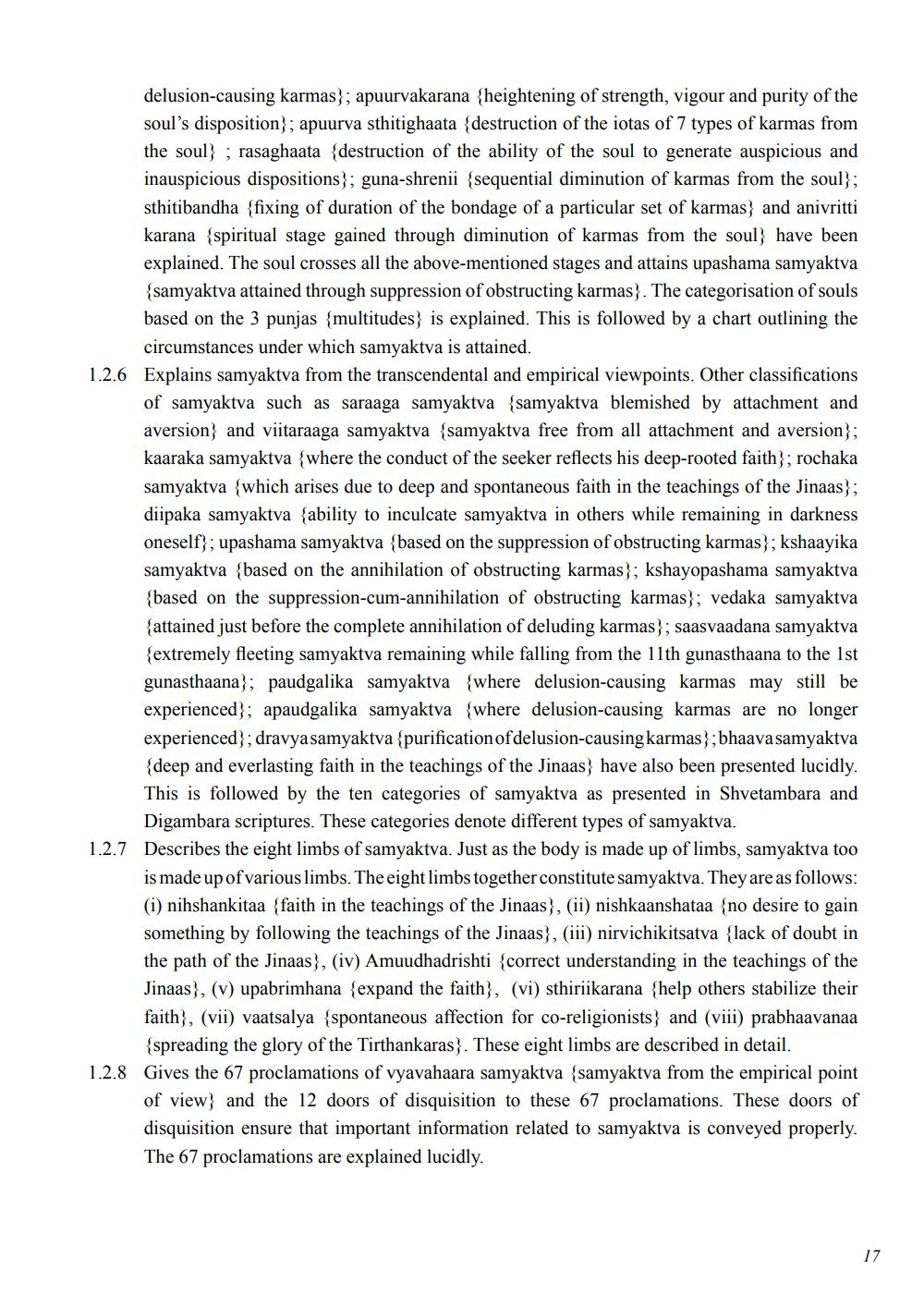________________
delusion-causing karmas}; apuurvakarana {heightening of strength, vigour and purity of the soul's disposition); apuurva sthitighaata {destruction of the iotas of 7 types of karmas from the soul); rasaghaata {destruction of the ability of the soul to generate auspicious and inauspicious dispositions}; guna-shrenii (sequential diminution of karmas from the soul}; sthitibandha (fixing of duration of the bondage of a particular set of karmas and anivritti karana spiritual stage gained through diminution of karmas from the soul have been explained. The soul crosses all the above-mentioned stages and attains upashama samyaktva {samyaktva attained through suppression of obstructing karmas). The categorisation of souls based on the 3 punjas (multitudes) is explained. This is followed by a chart outlining the
circumstances under which samyaktva is attained. 1.2.6 Explains samyaktva from the transcendental and empirical viewpoints. Other classifications
of samyaktva such as saraaga samyaktva samyaktva blemished by attachment and aversion and viitaraaga samyaktva samyaktva free from all attachment and aversion}; kaaraka samyaktva {where the conduct of the seeker reflects his deep-rooted faith}; rochaka samyaktva {which arises due to deep and spontaneous faith in the teachings of the Jinaas}; diipaka samyaktva {ability to inculcate samyaktva in others while remaining in darkness oneself}; upashama samyaktva {based on the suppression of obstructing karmas}; kshaayika samyaktva {based on the annihilation of obstructing karmas}; kshayopashama samyaktva {based on the suppression-cum-annihilation of obstructing karmas}; vedaka samyaktva {attained just before the complete annihilation of deluding karmas}; saasvaadana samyaktva {extremely fleeting samyaktva remaining while falling from the 11th gunasthaana to the 1st gunasthaana); paudgalika samyaktva {where delusion-causing karmas may still be experienced}; apaudgalika samyaktva {where delusion-causing karmas are no longer experienced}; dravya samyaktva (purification of delusion-causing karmas}; bhaava samyaktva {deep and everlasting faith in the teachings of the Jinaas) have also been presented lucidly. This is followed by the ten categories of samyaktva as presented in Shvetambara and
Digambara scriptures. These categories denote different types of samyaktva. 1.2.7 Describes the eight limbs of samyaktva. Just as the body is made up of limbs, samyaktva too
is made up of various limbs. The eight limbs together constitute samyaktva. They are as follows: (i) nihshankitaa {faith in the teachings of the Jinaas, (ii) nishkaanshataa {no desire to gain something by following the teachings of the Jinaas, (iii) nirvichikitsatva {lack of doubt in the path of the Jinaas), (iv) Amuudhadrishti correct understanding in the teachings of the Jinaas), (v) upabrimhana (expand the faith), (vi) sthiriikarana {help others stabilize their faith, (vii) vaatsalya (spontaneous affection for co-religionists and (viii) prabhaavanaa
{spreading the glory of the Tirthankaras). These eight limbs are described in detail. 1.2.8 Gives the 67 proclamations of vyavahaara samyaktva (samyaktva from the empirical point
of view and the 12 doors of disquisition to these 67 proclamations. These doors of disquisition ensure that important information related to samyaktva is conveyed properly. The 67 proclamations are explained lucidly.




